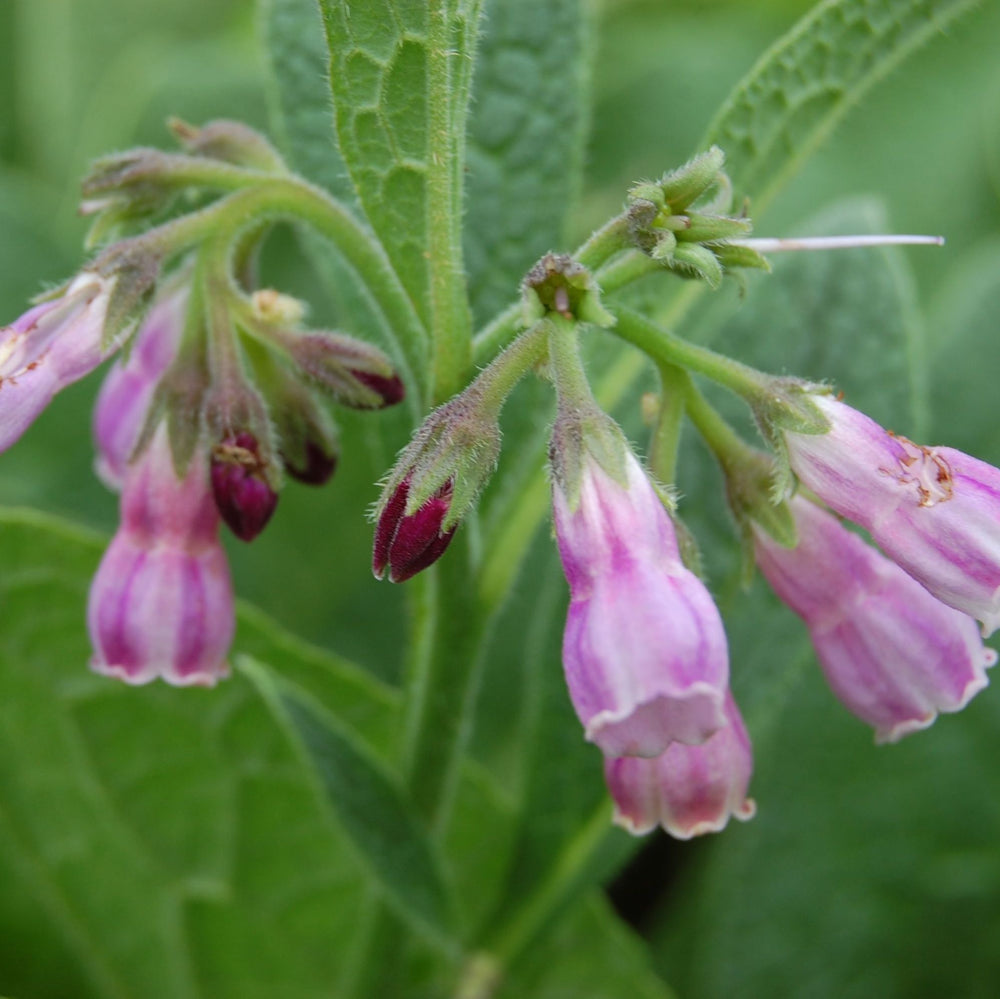
Organic comfrey uses, effects and benefits for the skin
Common comfrey is recognised as a medicinal herb. Comfrey leaves as well at its deep roots system has been recognised in folk medicine use for thousands of years. Its regenerative and wound healing properties, supporting cell proliferation, has been in extensive topical use of comfrey. This blog does not consider the oral use of comfrey.
What are the growing conditions for comfrey?
It is a perennial plant presenting hairy leaves, purple flowers, preferring a full sun position in fertile soils. New plant propagation is done through root cuttings or any root fragments with the first year of planting being the establishment of the plant, benefiting greatly from moist soil position. The following year, in early summer, new growth of basal leaves is seen. It is known that any root pieces produce a new plant during the growing season being summer. Fruit trees benefit from comfrey plants growing around their base as young leaves eventually decompose. Many gardeners add the leaves to the compost heap, supporting the composting process.
What are the use of comfrey for the skin?
Some of the possible uses include various comfrey products used a topical preparations such as:
Fresh leaves harvested and transformed into infused oil
Comfrey extract from comfrey leaf
External use of poultices of its leaves on unbroken skin
Overall, it’s a resourceful saviour in the home and garden such as in compost piles, not only for its support to other plants, but for its soothing effects on immediate and persisting skin, muscle and ligament concerns.
Recent scientific research about comfrey
Scientific studies continue to indicate its widespread use on a range of chronic and short-term skin issues in topical application. Although there has been a limited number of clinical trials, recently a systematic review of studies on the external benefits of comfrey indicated an improvement in ailments such as back pain, wounds, abrasions and ligament distortion [1]. More specifically, both infusions and extracts of various parts of the comfrey plant have shown to have profound benefits to blunt trauma and sport-related injuries, even against placebo study groups, this is including a double-blind study [2][3].
The beauty of fore mostly turning to herbs such as comfrey is that it will less likely cause adverse side-effects, particularly when applied topically and remaining aware of how it feels. This act not only requires you to maintain more bodily consciousness to assess how your skin is responding, but its chemical compounds are softer, allowing for extended use and with this, more profound healing.
Skincare products with comfrey
The Herbal Gardener’s Calendula and Comfrey ointment contains both infused certified organic (Australian Demeter Biodynamic) calendula and comfrey oil. Ointments are defined as a semi-solid formula, with a higher content of beeswax. This is beneficial as it sits longer on the skin for optimal absorption.
An infusion of comfrey allows the oil to extract the key chemical compounds without the solvent being too strong. This lower potency allows you to use it everywhere on the body. With the antibacterial and anti-inflammatory properties of calendula, the ointment provides complete restoration of the skin.
Our calendula and comfrey ointment is in our online store here.
You may also like this blog about the use of the calendula and comfrey ointment for people undergoing radiation therapy.
References
[1] A critical scoping review of external uses of comfrey (Symphytum spp.) - ScienceDirect
[2] Effect of a blend of comfrey root extract (Symphytum officinale L.) and tannic acid creams in the treatment of osteoarthritis of the knee: randomized, placebo-controlled, double-blind, multiclinical trials - ScienceDirect
[3] Tolerability and effectiveness of an antitrauma cream with comfrey herb extract in pediatric use with application on intact and on broken skin - ScienceDirect

